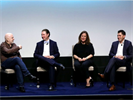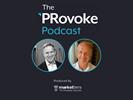Arun Sudhaman 02 Jul 2013 // 1:39PM GMT
In Cannes, it sometimes pays not to dig too deep with your questions. Where exactly did that award-winning ad run? Do the results for the latest celebrated campaign stand up to real scrutiny? Is that creative director really only 35 years old?
For at least one group of people at the annual festival, though, blissful ignorance is no longer an option. Senior marketers are now being asked to make an endless stream of decisions in the knowledge that their brand-building efforts will be dissected, analysed, criticised and - yes - perhaps even praised, by a digitally-fuelled crowd of instant pundits and participants.
This is the reality of the conversation economy, where organizations are finding that the one-way communication model is not only dead, but that people have the power to rapidly shift the terrain upon which a major marketing campaign may have been built. It is a shift that calls for a more participatory approach to brand building, where critics do not just have a voice - they may actually play a role in defining, sharing and developing your campaign.
For many marketers, these changes mean an overhaul of the traditional long-term, obsessively crafted campaign plan, instead calling for a more ‘realtime’ approach to communication - one that draws as much upon editorial savvy as it once relied upon big-budget theatrics. For many brands, meanwhile, the shift carries a much bigger element of risk, in an environment where a marketing message cannot be controlled and criticism of a company can spread like wildfire.
This is the spectre that overhangs all of the conversations about marketing at Cannes: the loss of control and the difficulties posed by a messy, chaotic social media environment where trust and advocacy must be earned. To explore these trends in greater detail, the Holmes Report joined forces with its creativity partner Ketchum to convene a special panel during the festival titled 'Creativity in the Conversation Economy, attended by an audience of senior marketing and PR professionals.
As Ketchum CEO Rob Flaherty put it, “the most valuable media in the world is the only kind you can’t buy. It’s the most hard to come by - a person talking to another person and it seems to be the currency that everyone wants to get today.”
“Social media has been like manna from heaven for the PR industry,” added Flaherty while introducing the panel. “Hopefully on a good day we take the skills we learned from many years working through gatekeepers, and having to earn the presence of a message, and we use it within the context of the most powerful channel of all - the human channel, people talking to each other.”
The following article reports the highlights of the discussion, touching upon such issues as the ‘brand ego’, the loss of control, the importance of failure, and how corporate concerns now affect branding efforts.
The panel
Rob Flaherty, CEO, Ketchum
Tom Scott, director of global brand and innovation, Bill & Melinda Gates Foundation
Kelly Vanasse, vice president of communications, Procter & Gamble Global Business Units
Moderated by: Arun Sudhaman, managing editor, Holmes Report
Loss of control: the 80:20 rule
Not before time, the idea that an organization can control its brand is inexorably losing steam. For marketers, however, this shift means they must rethink the traditional creative approach to their campaigns. P&G’s ‘Secret Mean Stinks’ effort is a good example of this trend, crowdsourcing much of the activity in a bid to boost awareness of bullying among teenage girls. As Vanasse pointed out, this type of thinking is not necessarily easy for an organization that is “used to being in control.”
Vanasse: It’s hard to change habits. We’re used to being in control. But what our brand builders are realizing is that when you cede control or let go, you get great stuff. The majority of [Mean Stinks] was user-generated content. It’s much more powerful than anything we could craft, package and send out. In terms of what it does to the expectation of creativity and what we need, everything starts with a story. So we need great storytellers. We need platforms like Mean Stinks versus just campaigns. We need people at our agencies and in-house who know what to do with that creatively, who know how to get the story started that will then lead to user-generated content, that will allow the girls, in this case, to take over the community. We think about the 80:20 rule - 80 percent of the time we give it up to them and that allows us to go in and do a little brand messaging about 20 percent of the time.
Scott: I am not in the business of building the Foundation’s brand for the brand’s sake. It is merely if it is a tool that helps us have conversations with the audiences we want to have conversations with. It’s all storytelling. We have access to the most amazing stories in the world. We are not telling them well. If we can find that mix between rational and emotional on the creative side, we can save more lives and do more things.
Flaherty: I think we all get the storytelling part. The question is what makes the storytelling really engaging. We see too many client organizations and agencies creating awesome content that they then either need to buy the presence of, or that sits there with a thousand links to it or views. The trick is to know the awesome story you want to tell but then do it in a way that other people care about. What’s going to create relevance? Agencies talk about mobilizing a movement. I think more brands need to find nascent movements and fuel them. Rather than trying to build their own.
Scott: If I get another agency come in and pitch me on how they are going to build a movement…
Flaherty: It can be a little bit of elegant organization, as simple as providing the hashtag, or an owned frame for the dialogue to continue.
Brand arrogance: “We need to be more humble”
Flaherty raised the concept of the ‘brand ego’ - the traditional urge for brands to conduct huge, set-piece marketing campaigns that are planned down to the tiniest detail, often cloaked in military metaphors that sees consumers targeted and audiences penetrated. The panellists discussed the need to reconcile that mindset, often so beloved of the C-suite, with the need for a more humble attitude that looks to listen and build on everyday stories told by people.
Vanasse: I call it brand arrogance. We need to be humble. We do that by putting the person first. Trying to get away from talking about consumers and talk about people. When you put the person first, you have a much easier time of being humble.
Despite being a nonprofit, the Gates Foundation is not immune to these challenges, given Bill Gates’ own stature as a lightning rod for attention and, sometimes, criticism.
Scott: It’s part of what keeps me up most nights. Our objectives are saving lives. It’s different to commercial objectives. The similar thing is around motivation. People have to understand our motivation and why we have chosen the areas that we focus on. We do have three brands…two of which are humans, and the other one has their names in it. One comes with 30 years of equity in a very public sense. These are people that are alive and out there and that’s different from a static thing you can manage.
Flaherty: All of this heavy interest in insights is a good thing. It’s an overused term but the desire to actually dig into something that people care about is terrific. Then, when you bring the paid, earned, shared and owned parts together you find that some of those parts come with more ego than others. Getting them to play nicely with each other in a way that cedes control is incredibly important. Leading with paid is frequently a way to be too intrusive and too brand ego-centric so I think more and more campaigns lead with the earned and shared part.
Vanasse: A lot of it has to do with the vibe and relationships that the internal teams share with each other, and the external agency teams share with each other, and that both share as one big team.
Fail fast, fail often…but recover well
The risks for brands that are looking to piggyback on the latest movements and memes are fairly obvious. Many brands have found this to their cost, misjudging the public mood and failing spectacularly in their attempts to jump on the news agenda. P&G global brand-building officer Marc Pritchard has said that he wants his marketers to “fail fast, fail often”. This is probably easier said than done, with the panel discussing the difficulties of encouraging an appetite for experimentation when so many people are ready to pounce on their mistakes.
Vanasse: It’s something that we’re hearing more and more. We are somewhat risk-averse as a company. As a 175-year-old company with so many brands, we have a lot to protect. That said, it’s really about how you recover when you fail, more than anything else. What we’re finding is that, if you recover the right way, you’re actually in a better position sometimes. I think when we share stories like that, it makes people more comfortable with leaning in, and stepping out and taking some more risk. I also say don’t take risks for risk's sake. We scenario plan through the nth degree, so that when we do take a risk, we have a good idea of what could happen from it. And we make sure we’re well prepared for something happening that we weren’t expecting and we’re ready to recover quickly.
Scott: Our asset, even more than our funding, is our convening power. We’re very much seen as a neutral actor, even though we have points of view on various issues. We take huge risks on our programmatic side - there’s a real culture of innovation and risk-taking and an acceptance that, if these issues were easy to solve, people would have solved them. So we have to try to push the limits of things there. And I think on the communications, side, we too are a little less risk tolerant. I think we can push things a little more.
Flaherty: We have been brought into situations where the client says ‘We have been approached by this comedian to do this work with our brand, should we do it?’ The way we prepare them for that is to not intervene and media train the comedian. It was to stay away but to do all the issues management around it. How do we recover fast if it doesn’t go well? How do we cede control of the brand, let them run with it, but be ready for any kind of backlash?
Corporate vs brand
Audience member Karen Van Bergen, CEO of Porter-Novelli, asked the panel how they get the balance right between corporate and brand storytelling. The question was given added piquancy by Flaherty’s subsequent remark that “when a brand gets into trouble, it now moves up to the corporate level a lot faster than it did only a decade ago.”
Scott: We have 26 strategies, it’s like having 26 business units. It has to ladder up to something, so that’s why we came up to this notion of ‘human promise’. If we can get that piece right, every single strategy can fit underneath that. I think that when we go to specific issue storytelling, we narrow our audience quite a bit, so we have to be focused on who we’re talking to and what we ultimately want them to do. It’s kind of an odd calculation.
Vanasse: Obviously, Olympics is a great example of how we were able to develop a company narrative, within which every single one of our brands could live and thrive and come to life in a really meaningful, beautiful way. That was a big strategic decision. We brought the P&G brand out.
Flaherty: The gap between the two does not exist anymore. I think it’s incredibly dangerous when a big company leads only with its brands. When the [corporate] brand is not defined, it will be defined only by the negative.


































.jpg)































